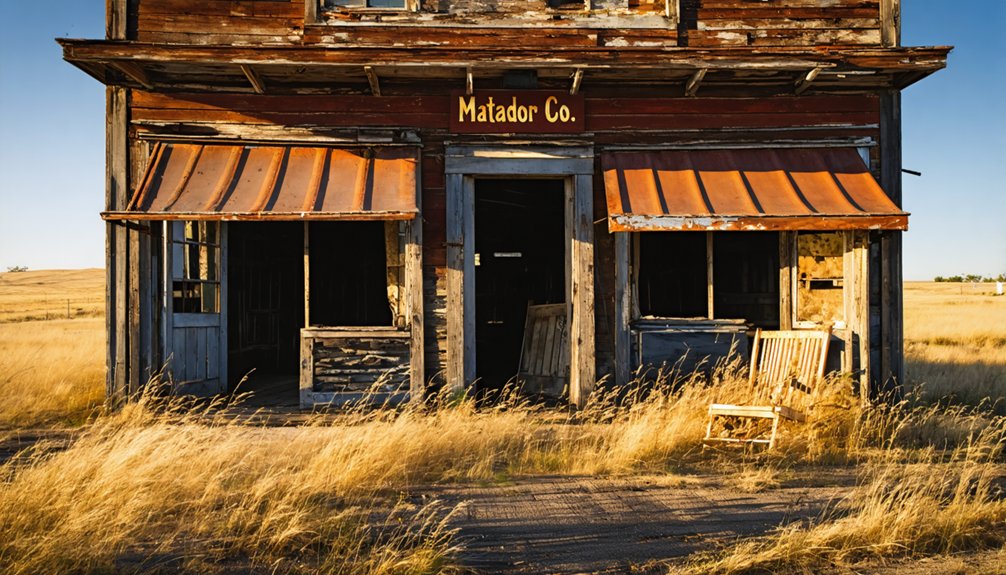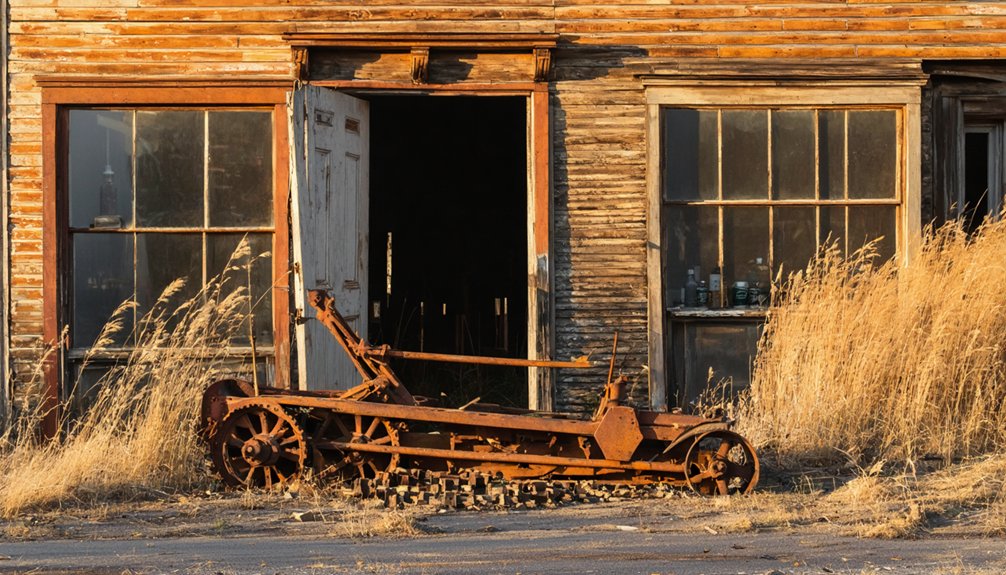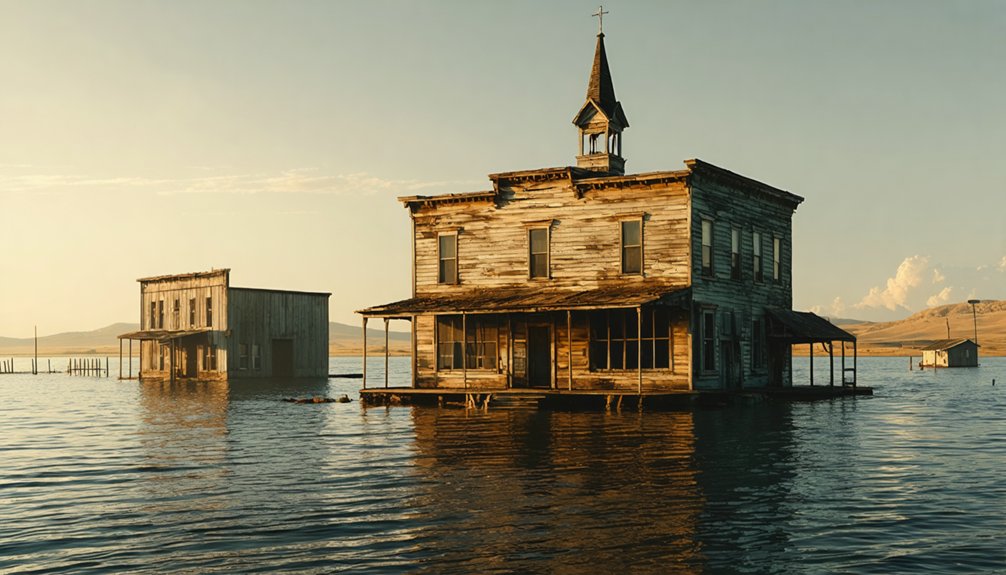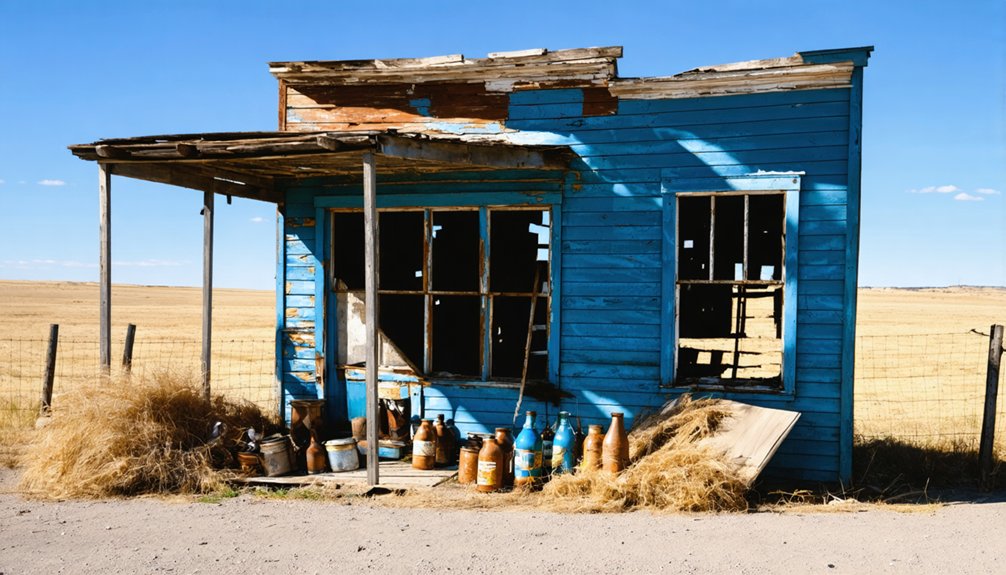You’ll find LeBeau’s ghost town history fascinating, from its 1875 founding as a French-Lakota trading post to its transformation into a major cattle-shipping hub. After the Minneapolis & St. Louis Railway arrived in 1906, the town boomed to 500 residents, moving 150,000 cattle through its stockyards in 1909 alone. The bustling main street featured an opera house, hotel, and various businesses before economic decline struck. Today, LeBeau’s remains lie beneath Lake Oahe’s waters, preserving countless untold stories.
Key Takeaways
- LeBeau was a thriving cattle-shipping town on the Missouri River, established in 1875 and reaching its peak population of 500 residents by 1909.
- The town’s economic success centered around its railway connection and massive cattle operations, shipping over 150,000 cattle in fall 1909 alone.
- Despite its prosperity, LeBeau declined in the 1920s when competing railroads diverted cattle routes, leading to the removal of its rail spur.
- The town became permanently submerged underwater following the construction of the Oahe Dam, effectively ending its existence.
- Archaeological excavations in 1954-1955 documented significant historical artifacts before the flooding, including earth lodge complexes and Indigenous settlements.
The Birth of a Trading Post Settlement
When Antoine LeBeau established his fur-trading post on the eastern bank of the Missouri River in 1875, he laid the foundation for what would become a bustling frontier settlement.
You’ll find the trading post origins deeply rooted in LeBeau’s own French and Lakota heritage, which helped forge strong connections with local Indigenous communities. The settlement quickly expanded to include both Native American traders and white settlers, growing to roughly 250 people and 60 buildings by 1880.
The multicultural influences of French and Lakota traditions shaped the community’s character, while the trading post served as its economic engine. After reservation lands opened for grazing, Matador Land and Cattle Company began extensive cattle operations in the area. Located near Swan Creek across from the Cheyenne River Reservation, the post dealt in furs, household goods, and various supplies needed by the diverse population. The town’s fortunes changed dramatically when the railroad moved south, causing a significant decline in local commerce.
Railway Connection and Economic Growth
You’ll find the key turning point in LeBeau’s growth came when the Minneapolis & St. Louis Railway extended its line to the Missouri River settlement in 1906-1907, establishing critical infrastructure for commerce.
The railroad’s arrival sparked a dramatic economic boom centered on cattle shipping, with some 25,000 head moving through LeBeau’s stockyards in a single 1908 season. Following common practice, the railway sold cheap land to farmers along its route to generate profits from shipping their agricultural products.
The Scotland-based Matador Land and Cattle Company’s lease of 500,000 acres of reservation grazing land at 3.5 cents per acre helped transform LeBeau into one of the West’s most important cattle shipping points between 1907 and 1910.
Railroad Infrastructure Development
In 1906, the Minneapolis & St. Louis railroad expanded its reach to LeBeau, marking a significant milestone in the town’s development. This strategic railroad expansion aimed to capitalize on the region’s livestock trade and grain shipments, promising substantial economic impact for the area.
The M&StL’s infrastructure development brought several key improvements:
- Construction of livestock holding pens and handling facilities
- Extension of the mainline from Watertown to the Missouri River
- Development of essential railway support structures
- Implementation of river crossing solutions
- Creation of connections to broader trade networks
You’ll find that LeBeau’s position as a Missouri River crossing point made it an attractive location for establishing major rail operations.
Townsite agent Thomas Way played a vital role in establishing LeBeau and other communities along the railway’s westward expansion.
However, despite the initial investment in infrastructure and the town’s promising start, logistical challenges and competition from other railroads ultimately limited its long-term success.
Cattle Industry Economic Boom
Following the arrival of the Minneapolis & St. Louis Railroad in 1906, you’d find LeBeau transformed into one of the most significant cattle shipping points of its era. The town’s population swelled from 200 to 500 residents as the economic impact of the cattle industry fueled remarkable growth.
In fall 1909 alone, over 150,000 head of cattle moved through LeBeau’s shipping yards. Like other locations listed on the LeBeau disambiguation page, this South Dakota town earned its own distinct historical significance.
You’d witness major operations like the Scotland-based Matador Land and Cattle Company fattening tens of thousands of steers on 500,000 acres of leased reservation land. The superior quality of South Dakota-fattened cattle commanded premium prices in Chicago markets.
LeBeau’s prosperity showed in its thriving businesses – banks, cafes, general stores, an opera house, and numerous saloons catering to the cowboy trade, all supported by the booming cattle economy.
Life During the Peak Years
During LeBeau’s peak years from 1906-1909, you’d find a bustling main street filled with banks, general stores, cafes, and professional offices serving 500 residents.
You could catch performances at Zimmer’s Opera House, play billiards at the Idle Hour parlor, or stay at the steam-heated Hotel LeBeau, which boasted quality cuisine and a strict no-dogs policy.
The town’s lifeblood flowed through its transportation links, where cowboys ferried cattle across the Missouri River to meet the Minneapolis and St. Louis Railroad for shipment to eastern markets.
Daily Commerce and Trade
While LeBeau began as a humble fur trading post in 1875, the town transformed into a bustling commercial hub by the early 1900s, supporting over 250 residents and 60 buildings at its peak.
Trading practices evolved from simple barter systems to sophisticated economic exchanges, driven by the railroad’s arrival and the booming cattle industry.
You’d find diverse commercial activities throughout LeBeau’s business district:
- Two banks offering credit and financial services for cattle operations
- Multiple general stores supplying everything from food staples to ranching equipment
- Professional services including physicians, dentists, and attorneys
- Hotels catering to travelers, featuring modern amenities like steam heat
- Entertainment venues such as the Idle Hour billiard parlor and various saloons
The town’s strategic location between Native American territories, cattle ranches, and railroad connections created a thriving marketplace that served diverse communities.
Social Life and Entertainment
As residents sought diversions from their daily work routines, LeBeau’s social scene flourished with an impressive array of entertainment options.
You’d find yourself drawn to Zimmer’s Opera House for cultural performances and community events, or spending evenings at the Idle Hour billiard and pool parlor.
The Hotel LeBeau became a central hub for social gatherings, where you could enjoy renowned cuisine while mingling with fellow townspeople.
If you were looking for livelier entertainment, the town’s saloons offered gaming and revelry.
The local churches – Baptist and Presbyterian – hosted community functions that strengthened social bonds.
With a population of 500 at its peak, you’d always find opportunities to connect with neighbors through various social activities, whether indoors or enjoying outdoor pursuits in the surrounding area.
Rail and River Transportation
The arrival of the Minneapolis & St. Louis Railroad in 1906 transformed LeBeau into a bustling hub of river commerce and rail activity.
You’d have witnessed the town’s rapid growth as the railroad constructed extensive facilities to handle the booming livestock trade, while the Missouri River continued its essential role in the region’s transportation legacy.
The combination of rail and river created an impressive transportation network:
- Regular train service began in 1907, primarily focused on livestock shipments
- 25,000 cattle moved through the stockyards in 1908 alone
- The Missouri River served as a significant ferry point for cattle crossing
- Railroad infrastructure included stockyards, engine house, and water tanks
- The Matador Land and Cattle Company utilized both river and rail for their operations
This transportation nexus made LeBeau a strategic shipping point until devastating fires in 1910-1911 began its decline.
The Matador Company’s Cattle Empire

Starting with a modest $50,000 investment in 1879, Matador Cattle Company grew from a small Texas operation of 320 acres into one of America’s most influential cattle empires.
You’ll find their Matador expansion included acquiring John Dawson’s 1,300 head and 8,000 “jinglebob” cattle from the Pecos Valley, rapidly building their presence across Texas.
The company’s fortunes shifted dramatically in 1882 when Scottish investors from Dundee purchased the operation, which by then included 100,000 acres and 40,000 cattle. Their investment of $1.25 million transformed the ranch’s future prospects.
Under Murdo Mackenzie’s innovative cattle management practices, the empire stretched into Kansas, the Dakotas, and Canada. His emphasis on managed care and pasture supervision revolutionized large-scale ranching operations, helping the company thrive even during challenging economic periods. The ranch expanded significantly in 1902 when they acquired 210,000 XIT acres in Texas.
The Matador V brand became a symbol of excellence in American cattle ranching.
Key Historical Events and Social Life
Founded in 1875 by French-Lakota fur trader Antoine LeBeau, this Missouri River settlement rapidly evolved from a modest trading post into a bustling frontier town.
Cultural interactions between Native Americans and white settlers shaped early commerce, while the arrival of the railroad in 1906 transformed LeBeau into a vibrant community of 500 residents.
- The town boasted modern amenities like the steam-heated Hotel LeBeau and a thriving opera house.
- Phil DuFran’s saloon and numerous gambling establishments dominated the social scene.
- Law enforcement challenges culminated in the 1909 killing of bartender Dode McKenzie.
- Churches and public gatherings provided balance to the frontier lifestyle.
- Trade relationships flourished as cattlemen paid 3.5 cents per acre for reservation grazing rights.
The combination of commerce, entertainment, and limited regulation created a uniquely free but sometimes volatile frontier atmosphere.
Archaeological Discoveries and Research

Beyond LeBeau’s frontier history lies a rich archaeological record spanning thousands of years of human activity.
You’ll find evidence of human occupation from Paleoindian times through Late Prehistoric periods, with sites revealing stone tools, projectile points, and burial grounds that showcase the region’s archaeological significance.
Near the Missouri River valley, researchers have uncovered prehistoric artifacts including pottery sherds and chipped stone tools, while earthwork features previously thought to be defensive structures are now being reinterpreted as possible ceremonial or social spaces. Recent analysis of fifteen archaeological sites along the Missouri River has provided evidence that many ditch earthworks may have served multiple purposes beyond fortification.
The area’s significance extends beyond physical remains – many sites hold deep cultural meaning for Northern Plains tribes.
Archaeological investigations continue to reshape our understanding of how different peoples used this landscape, from early mammoth hunters to later village-dwelling communities.
The Town’s Layout and Architecture
The ambitious layout of LeBeau reflected its early 20th-century aspirations as “The City of Promise.”
Situated on the east bank of the Missouri River near Swan Creek’s mouth, the town featured a carefully planned grid of ten streets and six avenues, with the Minneapolis and St. Louis Railway depot anchoring the intersection of Main and Railway streets.
The town planning embodied both practicality and optimism, with architectural styles typical of prairie settlements. The town’s buildings incorporated tin siding facades to provide settlers with a familiar, comforting appearance. Like many Black Hills communities, LeBeau’s fate was sealed when trucking operations replaced rail transport for cattle shipping.
You’ll find evidence of LeBeau’s strategic development in:
- The railway terminus positioning, maximizing transportation efficiency
- Residential lots arranged for systematic growth based on population milestones
- Commercial districts designed around cattle-shipping operations
- Vernacular building styles adapted to the prairie environment
- Infrastructure layout demonstrating forward-thinking urban development
From Boom to Submergence Under Lake Oahe

While LeBeau initially flourished as a bustling cattle-shipping hub after 1906, its prosperity proved short-lived.
You’ll find its cultural significance began to fade when competing railroads emerged west of the Missouri River, drawing cattle routes away from the town. By the early 1920s, economic decline had taken hold, culminating in the removal of the essential rail spur in 1924.
LeBeau’s destiny shifted as new rail lines west of the Missouri diverted vital cattle routes, leading to its economic downfall.
The town’s final chapter unfolded during the mid-20th century when the Oahe Dam project forever transformed the landscape.
Before the waters of Lake Oahe claimed the townsite, archaeologists from the University of South Dakota conducted significant excavations in 1954-1955, uncovering earth lodge complexes that revealed layers of history.
Today, you’ll find LeBeau’s remains resting silently beneath the reservoir’s waters, a submerged monument to boom-and-bust frontier ambitions.
Frequently Asked Questions
What Happened to the Descendants of Antoine Lebeau, the Town’s Founder?
While hundreds of LeBeau descendants from town founder Antoine still live across South Dakota, you’ll find many on Cheyenne River Reservation, where they’ve maintained their Native American heritage and community leadership roles.
Were Any Artifacts Recovered From Lebeau Before Lake Oahe Flooded the Area?
You’ll find minimal evidence of formal artifact recovery efforts before Lake Oahe’s flooding, though some bricks were salvaged and reused locally. Historical preservation mainly exists through photographs rather than physical artifacts.
What Was the Exact Depth of Water Covering the Former Townsite?
You’ll find the lake depth over the townsite varies between 30-40 feet when Lake Oahe’s at full pool (1,618 feet elevation), but during flooding fluctuations, it can drop 35 feet lower.
Did Any Businesses Successfully Relocate When the Town Began Declining?
You won’t find confirmed evidence of successful business relocation from the town. Economic challenges and rapid depopulation suggest most enterprises simply dissolved rather than transferring operations to new locations.
How Did Native American Tribes View the Establishment of Lebeau?
Like shadows across sacred land, you’ll find tribal perspectives viewed LeBeau’s establishment with deep suspicion, seeing it as another blow to sovereignty and a symbol of ongoing resource exploitation.
References
- https://www.southdakotamagazine.com/frontier-phantoms
- https://en.wikipedia.org/wiki/LeBeau
- https://www.sdhspress.com/journal/south-dakota-history-33-1/a-promise-broken-lebeau-and-the-railroad/vol-33-no-1-a-promise-broken.pdf
- https://core.ac.uk/download/pdf/345016075.pdf
- https://www.kwit.org/featured-programs/2019-02-11/bud-and-dode-and-death-in-le-beau
- https://en.wikipedia.org/wiki/List_of_ghost_towns_in_South_Dakota
- https://www.sdpb.org/rural-life-and-history/2023-12-11/the-gunfight-that-killed-a-town-sd-history
- https://cabinetcardgallery.com/2020/02/04/holding-a-claim-in-lebeau-south-dakota-log-cabin-husband-wife-and-two-dogs/
- https://en.wikipedia.org/wiki/History_of_South_Dakota
- https://history.sd.gov/museum/docs/FurTrade.pdf



